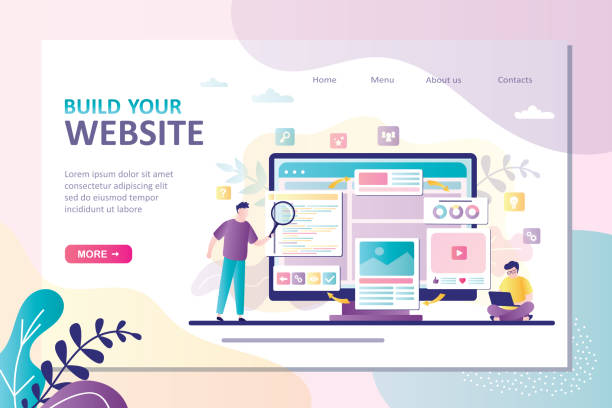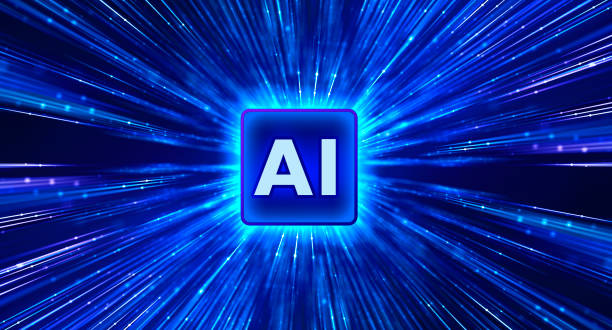The Importance of Globalization and Multilingual Website Design

In today’s world, where geographical boundaries have faded in the digital space, a strong presence in the #global_market is more vital than ever.
For companies and businesses looking to expand their operations and attract more audiences, multilingual website design is no longer a luxury choice, but a strategic necessity.
This approach allows you to communicate with your audience worldwide in their native language, resulting in increased trust, improved user experience, and ultimately significant business growth.
When your website is capable of providing content in multiple languages, you are essentially opening new doors to countless opportunities.
This action not only helps increase your #competitiveness in the international arena but also ensures your message reaches target audiences across the globe more effectively.
This is a fundamental step for any business that dreams of globalization and wishes to reach beyond local boundaries.
Providing information in different languages demonstrates respect for diverse cultures and languages, which can have a very positive impact on branding and customer loyalty.
Therefore, the multilingual website design approach is a smart investment for the future of any business.
Falling behind in the competition with large online stores?
RasaWeb makes your business online and increases your market share with professional e-commerce website design!
✅ Increased brand credibility and customer trust
✅ Easy shopping experience leading to more sales
⚡ Act now to get a free website design consultation!
Countless Benefits and Challenges Ahead in Multilingual Website Design

Implementing a multilingual website comes with numerous benefits that can significantly expand the scope of your activities.
The most important advantage is access to new markets.
By providing content in different languages, you automatically open new doors to customers who were previously unable to interact with your website due to language barriers.
This leads to increased website traffic and improved conversion rates.
Furthermore, your brand’s credibility and professionalism are enhanced at an international level.
A website presented in multiple languages demonstrates a global outlook and your readiness to serve diverse audiences.
However, multilingual website design is not without its challenges.
One of the biggest obstacles is accurate content translation and localization.
Literal translation alone is not enough; content must also be culturally and locally localized to be fully understandable and relevant to the target audience.
Managing and updating content in multiple languages can also be complex and time-consuming.
Also, SEO issues for each language and region, such as selecting appropriate keywords and correct URL structure, require expertise.
Therefore, although the benefits of multilingual website design are significant, careful planning and understanding the challenges are essential for success in this path.
Key Technical Considerations in Implementing Multilingual Website Design

When it comes to multilingual website design, technical aspects play a vital role.
Choosing the right technical structure forms the foundation for the success of your multilingual website.
The first step is deciding on the URL architecture.
Will you use subdomains (e.g., en.example.com), subfolders (e.g., example.com/en/), or country-code top-level domains (e.g., example.co.uk)? Each has its pros and cons in terms of SEO and management.
Using hreflang tags in the HTML code is essential for search engines to identify different language versions of a page and display the correct version to users in various regions.
These tags help prevent duplicate content issues and improve user experience.
Furthermore, your Content Management System (CMS) should have strong support for multilingualism; many modern CMSs like WordPress with appropriate plugins, or Drupal and Joomla, offer this capability natively.
Optimizing the database for storing and retrieving content in different languages, and ensuring the smooth performance of the website when switching languages, are other important technical points.
The website’s template design must also be flexible enough to support texts of varying lengths and display correctly in both right-to-left and left-to-right languages.
Finally, implementing a user-friendly and accessible language switcher on the website is crucial for easy user navigation between languages.
Here is a summary of key technical considerations in multilingual website design:
| Technical Item | Importance | Description |
|---|---|---|
| URL Structure | Very High | Subdomain, subfolder, or local TLD for each language. |
| Hreflang Tag | Critical | Guiding search engines to identify language versions. |
| Multilingual CMS | High | Native support or via plugins for content management. |
| Database | Medium | Optimization for storing and retrieving multilingual data. |
| Language Switcher | High | Ability for users to easily change the website language. |
Choosing the Best Strategy for Multilingual Website URL Structure

Choosing the right strategy for URL structure is one of the most important decisions in the multilingual website design process, directly impacting SEO and user experience.
There are three main options: country-code top-level domains (ccTLDs), subdirectories, and subdomains.
ccTLDs, such as .de for Germany or .fr for France, provide the strongest geographical signal to search engines and are beneficial for companies with a physical presence or a strong focus on a specific market.
However, managing multiple domains can be complex and costly, requiring separate domain authority building for each.
Subdirectories, such as example.com/en/ or example.com/fr/, are often recommended as the best option.
They are easier to manage because all language versions reside within a single main domain and benefit from its SEO authority.
This structure is simpler for webmasters and does not require separate SSL certificates.
Search engines can also easily crawl and index them.
Subdomains, such as en.example.com or fr.example.com, are also a popular option.
They offer good flexibility and can be hosted independently, which is beneficial for large organizations with separate local teams.
However, search engines might consider subdomains as relatively independent entities from the main domain, which can affect the distribution of SEO authority.
The choice between these strategies should be made considering business goals, budget, available resources, and the importance of geographical signals for your target audience.
This initial decision in multilingual website design can lay the foundation for the success or failure of your international strategy.
Does your current website convert visitors into customers or drive them away? Solve this problem forever with professional corporate website design by RasaWeb!
✅ Build strong credibility and branding
✅ Attract target customers and increase sales
⚡ Get a free consultation right now!
Beyond Translation: The Art of Content Localization and User Experience

Many believe that multilingual website design merely means translating content from one language to another, but this is a common and fundamental mistake.
The actual process that leads to success in international markets is called Localization.
Localization goes beyond literal translation; this process involves adapting content, images, colors, currency, dates, and even the tone and writing style to the cultural norms and expectations of local audiences.
For instance, a joke or idiom that is perfectly normal in one culture might be offensive or meaningless in another.
Furthermore, the website’s visual design should also be localized.
Colors may carry different meanings in various cultures, and images that are appealing in one country might not resonate or even be perceived negatively in another.
The goal of localization is to create a seamless and natural user experience for the visitor, such that they feel the website was designed for them and their culture from the outset.
This leads to increased trust, improved engagement, and ultimately higher conversion rates.
Neglecting localization can lead to undesirable consequences such as misinterpreting the message, creating a sense of foreignness, or even unintentional offense.
Therefore, every multilingual website design project must place localization at the core of its strategy to ensure that the brand’s message is conveyed correctly and with full respect for different cultures.
This investment in localization will yield a significant return in the form of customer loyalty and market expansion.
Search Engine Optimization (SEO) for Multilingual Websites

SEO for multilingual websites takes on more complex dimensions, as it must be optimized separately for each language and region.
The ultimate goal of multilingual website design is to be visible in search results for international audiences.
The first step in multilingual SEO is keyword research for each language.
Keywords that are effective in one language may not have an exact equivalent in another, or they may have different search volumes.
Therefore, using keyword research tools for each target market is essential.
The correct use of the hreflang tag, mentioned in previous sections, is critical.
This tag helps search engines like Google display the correct language and region versions to users and prevent duplicate content issues.
The appropriate URL structure also plays a significant role in multilingual SEO; the choice between subfolders, subdomains, or ccTLDs should be made considering SEO objectives.
Furthermore, website loading speed (Page Speed) is very important in different parts of the world.
Users in different countries may use varying internet connections, so optimizing images, code, and using a CDN (Content Delivery Network) can improve user experience and SEO.
Creating an XML Sitemap for each language and submitting it to search consoles helps crawlers find and index all your multilingual pages.
Internal and external link building should also be done carefully; links should point to relevant and authoritative language versions.
Finally, monitoring SEO performance for each language separately, using tools like Google Analytics and Google Search Console, is crucial for identifying opportunities and issues.
Multilingual website design without a strong SEO strategy cannot realize its full potential for attracting global audiences.
Enhancing User Experience (UX) in Multilingual Website Design

User Experience (UX) plays a pivotal role in the success of any website, and this importance is amplified when it comes to multilingual website design.
A poor user experience can render even the best translated content ineffective.
The first and most important element is the easy discoverability and usability of the language switcher.
This switcher should be clearly visible on the website, and users should be able to easily select their desired language.
It is usually located in the upper right corner of the page or in the website’s header section.
Additionally, the visual design must be flexible to prevent layout issues arising from varying text lengths in different languages.
Some languages (like German) can have much longer words than English, while others (like Chinese) occupy less space.
Also, supporting different writing directions (LTR for English and RTL for Persian or Arabic) is very important.
The website should automatically adjust the writing direction based on the selected language.
Ensuring that all clickable elements, buttons, menus, and forms are correctly displayed and function properly in all languages is essential.
Furthermore, page loading time should be optimized across all geographical regions.
Using a CDN to distribute content from the nearest server to the user can help improve loading speed.
Attention to these details in multilingual website design not only increases user satisfaction but also positively impacts conversion rates and SEO.
The table below highlights some important UX elements in multilingual website design:
| UX Element | Importance | Description |
|---|---|---|
| Clear Language Switcher | High | Flag icon or language name, easy to locate. |
| RTL/LTR Support | Critical | Automatic adjustment of writing direction (right-to-left/left-to-right). |
| Responsive Design | Very High | Adaptation to varying text lengths and different devices. |
| Speed Optimization | High | Fast page loading in all regions. |
| UI/UX Localization | High | Adapting icons, images, and formats to local culture. |
Common Mistakes in Multilingual Website Design and Ways to Avoid Them

On the path of multilingual website design, there are some common mistakes that can render your efforts and investments ineffective.
The first and perhaps biggest mistake is using machine translations without human review.
While machine translation tools have advanced, they can never accurately convey cultural nuances, idioms, or appropriate tone, leading to unnatural, humorous, or even offensive text.
Always use native and professional translators and implement a thorough review process.
Another mistake is ignoring local SEO for each language.
Simply translating keywords is not enough; appropriate keywords for each specific market and language must be researched and optimized.
Incorrect use of hreflang tags can also lead to SEO issues, causing search engines to confuse which language version of the page to show to users.
Neglecting User Experience (UX) is also a common mistake.
Inability to support different writing directions (RTL/LTR), mismatch of text lengths with layout, or not placing the language switcher in an accessible location can lead to a poor user experience and users abandoning the website.
Also, lack of continuous content updates in all languages is a problem.
If one version of the website is updated while others remain outdated, users become confused, and brand credibility decreases.
Finally, choosing an inappropriate CMS that lacks strong multilingual support can lead the entire project to a dead end.
By avoiding these common mistakes and making proper investments in translation, SEO, and UX, a successful multilingual website design can be achieved that truly helps your globalization goals.
Are you worried your company’s old website will drive away new customers? RasaWeb solves this problem with modern and efficient corporate website design.
✅ Increases your brand’s credibility.
✅ Helps attract target customers.
⚡ Contact RasaWeb for a free consultation!
The Future of Web Design and Innovations in Multilingualism

The field of multilingual website design is rapidly evolving, and with technological advancements, exciting innovations are on the horizon.
One of the most significant developments is Artificial Intelligence (AI) and Machine Learning (ML) in translation and localization.
While machine translation is not yet a substitute for human translation, it is becoming increasingly smarter and can be used as a powerful tool to increase speed and reduce initial translation costs.
It is expected that in the near future, AI systems will be able to better understand cultural context and provide more accurate and localized translations.
Another emerging trend is advanced content personalization based on the user’s geographical location and language preferences.
Using spatial and behavioral data, websites can automatically suggest relevant content and the appropriate language to users, even before the user manually selects the language.
This approach significantly improves the user experience.
New web technologies such as Progressive Web Apps (PWAs) and Jamstack are also changing how multilingual websites are built.
PWAs, by offering a mobile app-like experience and offline functionality, can improve access to multilingual content in various conditions.
Jamstack, by separating the frontend from the backend and utilizing APIs, makes multilingual content management easier for developers and increases website speed.
Finally, the focus on Voice Search and conversational interfaces is also increasing, which highlights the need to optimize multilingual content for voice searches.
These advancements indicate that multilingual website design will not only be easier and more efficient in the future but also capable of providing much richer and more personalized user experiences.
Conclusion and Next Steps for Global Success

In this article, we explored various aspects of multilingual website design, analyzing its importance in global markets, technical complexities, localization challenges, SEO considerations, and enhancing user experience.
It is clear that merely translating text is not enough; for true success in the international arena, a comprehensive and planned approach is needed that encompasses all technical, content, SEO, and UX aspects.
Multilingual website design is a long-term strategic investment that can provide countless opportunities for your business’s global growth and expansion.
What are your next steps? First, clearly define your goals: Which markets are you targeting and why? Then, consult with a specialized team in multilingual website design who are proficient in both technical aspects and familiar with SEO and localization principles.
Prioritize investment in quality translation and localization.
Use appropriate tools to manage content and monitor your website’s performance in different markets.
Continuously keep your content updated and monitor its performance in each language.
With this proactive and intelligent approach, your multilingual website will not only become a gateway to global markets but also a strong bridge for deeper and more meaningful communication with your international audience.
This path may be challenging, but its reward in the form of business growth and increased brand influence globally will be unparalleled.
Frequently Asked Questions
| Question | Answer |
|---|---|
| What is a multilingual website? | A website whose content is available to users in more than one language. |
| Why should I make my website multilingual? | To reach a wider audience in global markets, improve user experience, and enhance international SEO. |
| What are the technical approaches to building a multilingual website? | Using subdirectories, subdomains, or URL parameters to differentiate languages. |
| How does multilingual design affect SEO? | By targeting local keywords and providing content in users’ native languages, the website’s ranking in search engines for those regions improves. |
| What are the challenges of multilingual website design? | Content translation management, support for right-to-left (RTL) orientation, technical issues related to language addressing, and maintaining design consistency. |
| How do we choose the languages for a multilingual website? | Based on target audience analysis, desired markets, and current website traffic data (if available). |
| What is RTL support and why is it important for some languages? | Right-to-Left, the display direction of text and page elements from right to left, which is essential for languages like Persian, Arabic, and Hebrew. |
| How do we manage multilingual website content? | Using multilingual Content Management Systems (CMSs), translation plugins, or professional translation services. |
| What is the user experience (UX) like on a multilingual website? | The ability to easily change the language should be provided, and the translated content should be of high quality so that users feel comfortable. |
| What are common CMS platforms for multilingual websites? | WordPress (with plugins like WPML), Joomla, Drupal, and Shopify (with relevant settings or plugins). |
And other services of RasaWeb Advertising Agency in the field of advertising
Smart Direct Marketing: An exclusive service for growth in SEO ranking improvement based on attractive UI design.
Smart Customer Journey Map: An exclusive service for growth in customer acquisition based on SEO-driven content strategy.
Smart Link Building: Professional optimization for customer acquisition using attractive UI design.
Smart Marketing Automation: An effective tool to increase website traffic with the help of real data.
Smart Custom Software: A fast and efficient solution for user interaction focusing on marketing automation.
And over hundreds of other services in internet advertising, advertising consultation, and organizational solutions
Internet Advertising | Advertising Strategy | Advertorial
Sources
Search Engine Optimization for Multilingual Websites
Importance and Benefits of Multilingual Website Design
Key Tips for Professional Website Design
WordPress Plugins for Multilingual Websites
? In today’s competitive world, a strong online presence is your key to success. RasaWeb Afarin, by providing comprehensive digital marketing solutions including responsive website design, SEO, and social media management, elevates your business to new heights. Build your digital future with us.
📍 Tehran, Mirdamad Street, next to Bank Markazi, Southern Kazeroun Alley, Ramin Alley, No. 6




